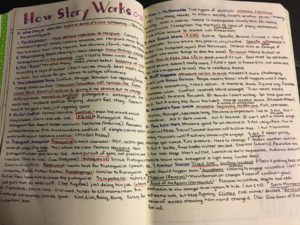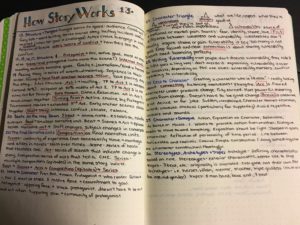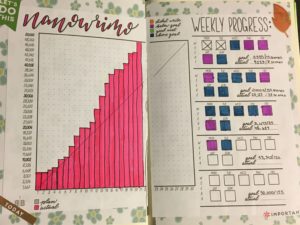Patriarchy in Tennessee Williams’ A Streetcar Named Desire
Modern pop culture has largely turned Tennessee Williams’ most significant play into a punchline. Today’s generation is more familiar with a drugged-up Elaine on Seinfeld screaming the name “Stella” or the Simpsons’ musical parody episode in the early 1990s. The play, written in 1947 and memorialized in film in 1951, is not a comedy, and Marlon Brando’s star-turn as the violent Stanley Kowalski is more than a handsome man in a white shirt screaming his wife’s name outside the window. The play illuminates the role that patriarchy has played not only in our own lives but in the culture that we consume and continues to do so today. Blanche DuBois, a faded Southern belle arrives on her sister’s doorstep, and clashes with her brother-in-law, the aforementioned Stanley, in a vicious battle of the sexes that culminates in Stanley raping Blanche and the latter being sent away to an asylum, her fragile nerves entirely shattered. Williams’ play ends on this note—Blanche leaving, her sister Stella remaining with Stanley, and Stanley going on to live his life with his wife and child. In the film, Stella was depicted as leaving her husband, but it is difficult to imagine that lasting any longer than it did in Scene 3.
How useful is it to examine decades old literature and entertainment through the more modern lens of feminism? Is it fair to apply new sensibilities to culture our grandparents consumed? Is it right to call Stanley Kowalski a misogynist or characterize his relationship with Stella as an abusive one, with Stella showing the signs of being a battered wife? What is the value in approaching a play written before the women’s liberation movement of the 1960s and the 1970s using this view?
Pamela Anne Hanks argued that this is really the only way to look at older literature, referring to the contemporary response theory. She writes that “it is because the beliefs, values, and attitudes, the prevailing thought of the day, are themselves composed of competing elements that literature presents—not a copy of those thought systems but a reaction to them.” (Hanks) In other words, every generation sees something different in the entertainment they watch, and it is natural to look critically at these influential works that are often remade decades later and analyze what they tell us about our society today. Hanks was writing from the perspective of a more recent production of Streetcar, a television movie that depicted the ending rape scene in more graphic detail than either Williams’ screenplay or Elia Kazan’s Academy Award winning film. Williams himself clearly agonized over this rape scene; Brenda Murphy referred to several versions of it that would have offered very different ideas to the audience. In one, “Blanche and Stanley seemed to have made love with mutual attraction” and in another version, cut just before the play premiered, Stella had a line to Eunice in which the word rape was used explicitly while she “held up Stanley’s pajama a top, which had been ripped to shreds, and said that his shoulders and back were covered with scratches.” Williams sent a letter to Kazan before the latter signed onto the production, suggesting that Stanley was not a cut and dried villainous type. (Murphy) He wanted to maintain a moral ambiguity—by the standards of the late 1940s and 1950s—and for him, a scene in which Stanley “springs toward her, overturning the table…she cries out and strikes him with the bottle top but he catches her wrist” created that ambiguity because directly after this stage direction, Blank “sinks to her knees” and Stanley carries her to the bedroom. For an audience in this time period, this can be construed as Blanche giving in and submitting. (Williams) No such ambiguity existed in the 1984 version according to Hanks—in the 1980s, Blanche struggles against her attacker who ultimately overpowers her.
How we envision consent and sexual assault between men and women has changed in the last seventy years to be sure. At the time Williams wrote his play, marital rape did not exist as a concept (and in some states, remains legal even today), and rape itself was a taboo subject. If a woman acted a certain way, she was clearly asking for it. The careful building up Blanche’s character throughout the play as a woman who has stepped outside the moral confines of decent society and engaged in premarital sex prepared the audience to believe Blanche was complicit in her own rape. When she is sent away to the asylum in Scene Eleven, the audience might actually be relieved to see the poor woman finally getting help while being assured that Stella and Stanley are free of her, able to go back to the happy life they lived prior to Blanche’s arrival. Anca Vlasopolos argued that in order to dominate and ultimately vanquish Blanche, Stanley had to “tap into the dominant discourse of patriarchy” and that ultimately, in many ways, Blanche could be seen as being punished for her nonconformity and promiscuous nature by being sent to an asylum. After all, what proof is offered for her committal? Williams does not offer any lines that suggest she has been diagnosed. Blanche is a woman alone in the world; Vlasapolos wrote that this ending suggests what women have always known: “we are not safe so long as the measure of insanity depends on the powerlessness of the individual.” (Vlasopolos)
We might argue that the way in which Williams constructed this narrative and Blanche’s story was part of another time, and that the character of Stanley could never be written today but unfortunately, that is not true. The patriarchal construction of our society has always lifted the man above the woman—we revere shows written about the anti-hero: Breaking Bad, Mad Men, The Sopranos. One of television’s most popular couples on daytime soap operas was Luke and Laura on General Hospital, and their relationship began with a rape in 1979. Two years later, twenty million people watched them get married and Princess Diana herself sent the performers a bottle of champagne. When the show revisited that storyline in 1999, after their teenaged son learned the history, Laura brushed aside her own trauma in order to make Luke feel better about what he’d done and convince him to return to their marriage. One of the most important romance novels began with a rape scene: The Flame and the Flower by Kathleen Woodwiss, published in 1973. The hero rapes the heroine because he thinks she is a prostitute. They go on to marry and live happily ever after. The rape trope in romance continued throughout the 1970s into the 1980s because women were not supposed to enjoy sex—they had to be talked into it, they had to be overpowered. One can even find this trope in the 1990s as Days of Our Lives depicted a marital rapist, Jack, who was redeemed by the love of a good woman, Jennifer. The couple of Jack and Jennifer came to be known as a so-called super couple, despite Jack’s past. The society that thought the way Williams wrote Blanche’s rape offered even the slightest bit of ambiguity raised young women who read these novels and watched these soap operas in which women were sacrificed in favor of damaged men.
Another aspect of Stanley’s character that does not hold up to Williams’ claim of ambiguity is his violence and brutish nature. In several areas, Blanche is shown to have a poor attitude of her brother-in-law. She shows him derision by calling him a Polack and complaining about their small apartment in their run-down neighborhood. No one would blame Stanley for being angry that his wife’s sister, whom he is entirely supporting, shows no gratitude for having a place to rest her head after losing her family home. But Stanley takes his anger out on his wife, destroying Stella’s radio and then hitting her when Stella protests. He attacks his pregnant wife, and even his own friends step in. Williams’ stage direction reads that “Stanley is forced, pinioned by the two men, into the bedroom. He nearly throws them off.” One might think that this indicates that they do not approve of his rough treatment. But then they make excuses for him. “They speak quietly and lovingly to him and he leans his face on one of their shoulders.” Mitch, who later becomes Blanche’s beau, suggests that somehow the women are to blame because “poker shouldn’t be played in a house with women.” He says to Stanley “you blew your top” – they spend more time caring for Stanley and then only Blanche seems worried about the pregnant woman who was just struck by her own husband. Their upstairs neighbor, Eunice, to whom Blanche and Stella turn for the night, suggests that “you can’t beat on a woman an’ then call ‘er back”. (Williams) Eunice appears to be on Stella’s side, criticizing Stanley but at the end of the play, it is Eunice whom Stella tells that she could not live with Stanley if she believed Blanche, and Eunice is in sympathy with her. Both of them are women in a cold, cruel world that has just made it clear what happens to women who step outside of the traditional homemaker molds. When Stella ends up with Stanley at the end of the play, this fits in with the 1950s understanding of a woman’s role. Vlasapolos writes that Eunice’s final assessment is “pragmatic” something even viewers who have sided with Blanche can understand. Eunice tells Stella about Blanche’s story “Don’t ever believe it. Life has to go on. No matter what happens, you’ve got to keep going.” (Williams)
Williams wrote his play intending for his figures to remain morally ambiguous. In that letter to Kazan, he wrote that “the only point the play makes, he insisted, is ‘the point or theme of human understanding…in the end you should feel—‘if only they all had known about each other.’” (Murphy) It is difficult, more seventy years later, to really accept this as the true point of the play. Would Stanley and Blanche have had different endings if they had understood one another better? It seems to me as a reader that they understood each other quite well. Stanley knew Blanche had lost everything, and that she had suffered a tragic loss of her husband at a young age. He knew that she felt as though she was superior to him (though no, he did not understand that Blanche’s superiority was little more than armor over an incredible fragile mind), and he knew that she had nowhere to go. He knew that his wife loved his sister for all her faults and depended on her. Stanley, even by Williams’ own standards, knew who his sister-in-law was, and that did not stop him from destroying her dignity, her hope for a future, and ultimately, even her own mind as it is clearly his sexual assault and her sister’s lack of belief in her that destroys Blanche’s fragile grasp on reality. Blanche also saw her brother-in-law as a brute who likely beats her sister. What more understanding was Williams looking for?
This play is a product of its time and a product of the way men thought about themselves and the world around them. Stanley, according to Williams’ is not the villain. No one is. Generations of women who have read this play, seen it performed or watched the adaptations, find that difficult to believe. Stanley Kowalski represents a piece of popular culture we are still struggling to excise: the brooding anti-hero that needs the love of a good woman to be better. Williams’ ending suggests that Stella and Stanley will probably be all right now that Blanche is out of the picture; that Stella and their child will soften his rough edges. This is why it is essential that society turns a critical eye to older pieces of entertainment to understand why women think it is their responsibility to fix a man. Why did Laura have to make Luke feel better about raping her? Why was Jennifer responsible for Jack’s redemption? Why did Stella have to stay with Stanley and sacrifice her sister? Popular women’s culture loves to write that women can save a man, that he can be redeemed through her morality and strength. One can cite numerous examples from soap operas and prime time television, from romance novels and even mainstream fiction. This is the trope that Williams’ Streetcar depends on: men like Stanley can be fixed while women like Blanche are irretrievably broken. It was true in 1947, and in many respects, it remains true in 2019.
Works Cited
Hanks, Pamela Anne. “Must We Acknowledge What We Mean? The Viewer’s Role in Filmed Versions of “A Streetcar Named Desire”.” Journal of Popular Film and Television 14 (1986): 114-122.
Murphy, Brenda. “On A Streetcar Named Desire.” The Play and Author. n.d. (I have to track this source down, it was a pdf given to us in class)
Vlasopolos, Anca. “Authorizing History: Victimization in “A Streetcar Named Desire”.” Theatre Journal 38 (1986): 322-338.
Williams, Tennessee. A Streetcar Named Desire. New York: New Directions Books, 2004.







